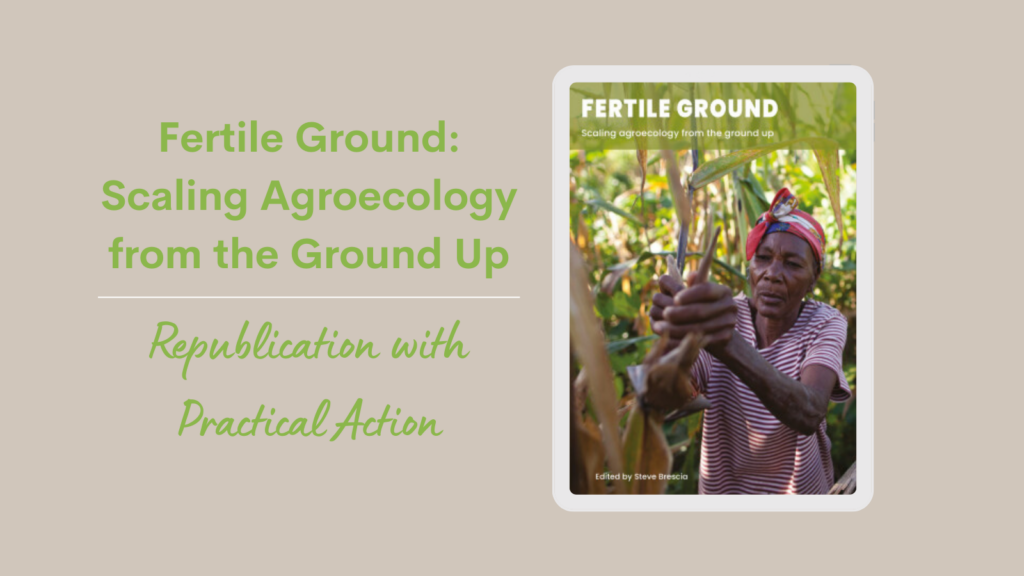What Fertile Ground Teaches Us About Scaling Agroecology
It is increasingly clear that the rules by which we have organized our broader economic and political systems, with our agricultural and food systems at their center, are generating overlapping economic, environmental, social, and political crises. Our general ‘operating system’ is broken and has led us to what many are now referring to as a ‘poly-crisis.’ Industrialized agricultural and food systems are major drivers of climate change, environmental destruction, the dangerous erosion of biodiversity, persistent global hunger and poverty, the displacement and migration of millions of rural people, as well as the rising global epidemic of obesity and diet-related diseases. Any society that wishes to thrive long-term must organize itself around the goals of generating well-being for its citizens, and sustaining rather than destroying the ecosystems upon which we all depend. We are currently not operating by rules that that generate the common good. If that is indeed our goal, it is profoundly clear that systemic changes are required. But how?
There are about 2.5 billion people in the world, on 500 million farms, involved with smallholder family agriculture and food production (FAO, 2016). That is close to a third of the world’s population. Their creative capacity to farm productively and sustainably with nature, instead of against it, is perhaps the most powerful force that can be unleashed to overcome the interlinking challenges of hunger, poverty, climate change, and environmental degradation. This is the essence of agroecology.

Food sovereignty, as articulated by the global farmers’ movement La Vía Campesina, is “the right of peoples to healthy and culturally appropriate food produced through ecologically sound and sustainable methods, and their right to define their own food and agricultural systems” (Vía Campesina, 2007). Agroecology is a vital pathway to achieve those rights, a source of positive change to transform the practices and rules of our broken farming and food systems.
As a field, agroecology continues to grow and generate viable and scalable solutions for a just transition toward sustainable, healthy diets, regeneration of soils and landscapes, and helping farmers and pastoralists adapt to and mitigate climate change. For those reasons it is gaining increasing support in many institutions, including UN’s Food and Agriculture Organization (FAO), as well as governments, international development agencies, university programs, and funders. Most importantly it is growing among farmers, producers, as well as consumers of food – which of course is all of us.
In light of the recent explosion of concern about the dangers of, and false solutions promised by artificial intelligence networks, agroecology is by its nature a vast and global human intelligence network that is generating real solutions. It is a network of farmer innovators, and their allies in science, civil society, and government, that is distributed across interfacing with the diverse ecosystems of the entire planet. At its core, it is about food sovereignty, enabling localized innovation and production, control over seed, land, and trees, as well as localized markets and consumption. It is pro-people, pro-environment, pro-appropriate technological innovation, pro-local jobs, pro-ground-up economic development, and pro-democratization of knowledge, power, and resources.
A just transition away from fossil fuel dependence is necessary and feasible in the energy and transportation sectors. A just transition is also required with agriculture and food systems, which have among the highest potential for reducing greenhouse gas emissions as well as drawing down carbon out of the atmosphere. Farmers around the world are demonstrating that it is possible to regenerate soil fertility and food production that relies on biology and ecosystems, rather than fossil fuel-dependent chemical inputs. It is possible to transition from vulnerable, long supply chains that increase risks for local consumers and reduce opportunities for smallholder farmers, to healthier, localized markets and circular economies.
To achieve this transition, smallholder farmers and their allies require resources and policy supports. Some have commented that the scarcest resource in the world today, and the one required to unlock other resources, may be imagination – the willingness to see beyond our current paradigm, and take actions to create a better one.
The cases and lessons from our book Fertile Ground: Scaling Agroecology from the Ground Up, and other documentation like it, show how farmers, communities, and consumers around the world are already linking their imaginations to tenacious efforts to organize and act in order to generate solutions in some of the most challenging conditions in the world. Taken together, their work provides guideposts in the struggle to create healthier agricultural and food systems, as well as societies.
As Million Belay, Director, Alliance for Food Sovereignty in Africa (AFSA) writes in his forward to the book:
Fertile Ground, highlights vital strategies to make agroecology a widespread reality in Africa and beyond, and to save ourselves and our planet. We need to support indigenous knowledge and innovation. We need to integrate agroecology into all policy arenas. We need to raise the consciousness of consumers about the sources of their food and the importance of healthy and nutritious food. We need to incorporate it in all levels of education so that we do not produce an army of misinformed academics who push industrial agriculture down our throats. Agroecology is not against science and technology, yet we need to facilitate the innovation of technologies that really improve the lives of farmers in lasting ways. We need to encourage small agricultural business to engage in agroecology.
I believe change is coming. Academic institutions, governments, faith-based organizations, and business are talking about and promoting agroecology. UN bodies are opening up to the concept and the practice. World social movements are more and more organizing under the umbrella of agroecology.
Agriculture is the single most powerful force unleashed on our planet since the end of the ice age. If we do not do something about agriculture’s current impact on our planet, we are in deep trouble. The bright side, as the collection of cases in this volume show, is that we are making agroecology our story, our solution, and our future.
Pathways from the crisis to solutions
For the authors of this Fertile Ground, agroecology is a people-centered and farmer centered process of agricultural innovation and rural development. It is a process that both requires and strengthens the agency, creativity, and power of farmers and their organizations. Multiple reports have already documented the benefits and techniques of agroecological farming.
Fertile Ground seeks to build upon this work by addressing two key questions:
- What strategies work to spread agroecological farming more widely?
- How can this contribute to systemic changes in our farming and food systems?
We tackle these questions by taking a ground-level approach, through case studies based on practical experiences. We draw insights and lessons from nine grounded cases from different national contexts around the world. In Brazil, the Borborema Pole territorial organization is building upon farmer innovation to create a new paradigm for “living with the semi-arid.” In Honduras, a 40-year-old agroecology movement struggles to make space for positive change in the face of an undemocratic government. A group of peasant associations in Haiti are building democratic processes and regenerating rural communities. In Ecuador, a collective of organizations is linking rural and urban communities to invest their local food budget in healthy agroecological production. A farmer and scientist duo in California is creating a model for transitioning strawberry production in the US to be organic and socially just. The Barahogon association in Mali is recovering its traditional role in regenerating trees to improve their Sahelian landscape. In Burkina Faso, Tani Lankoandé tests strategies to restore organic matter to her hardpan soil, working to make it productive again and teaching other women to do the same. Farmers, women’s associations, traditional chiefs, and civil society organizations in Ghana are linking arms to protect farmers’ rights to produce and save seeds. Finally, farmers collaborate with scientists in the Northern Frisian Woodlands of the Netherlands to develop “closed-loop farming.”
These cases highlight the work of farmers and their organizations, but also that of non-governmental organizations (NGOs) and scientists working with them. Common threads are that each case portrays individuals and organizations who are building pathways to scale agroecological farming by recognizing the importance of on-farm innovation, supporting the autonomy of farming communities, and working toward horizontal transmission of knowledge and the creation of local market linkages and more enabling policies.
Since the 1950s, there has been a growing corporate concentration of the ownership of agricultural knowledge, technology development, inputs, seeds, and supply chains. This commercial expansion of industrialized agriculture too often displaces the logic of farmer-centered agroecology. People and nature are removed from the center of the equation, and the space for expanding agroecology, and the agency of farmers and their organizations, shrinks. To reverse this, agroecological processes and support processes need to be scaled.
Fertile Ground tackles scaling agroecology at three levels: depth (farmers constantly deepening their innovation and improving their farming systems), breadth (spread among many farmers), and verticality (fostering enabling policies and markets). When we speak of “scaling agroecology” in this book, we are referring not just to promoting a set of technologies, but to promoting the conditions and processes for continuous, farmer-centered agricultural innovation with nature instead of against it. By design this will generate diverse practices, based on shared principles, adapted to local contexts. We must change not simply the techniques of farming, but the ways that farming is supported by agricultural ministries, philanthropies, NGOs, and scientists, so that farmers can continue to advance their context-specific processes of innovation.
As societies, we make choices to create the economic, political, as well as farming and food systems that we have. To overcome poverty, hunger, and climate change, we need to make choices, such as those portrayed in this book, to shift from business as usual to a new paradigm that strengthens the creative power of family farmers and their organizations and spreads agroecology for healthier farming, food systems, and economies. We offer the examples and lessons from Fertile Ground to organizations of farmers, consumers, non-governmental organizations (NGOs), policy-makers, and academics who are working toward these same goals.
Download your copy of Fertile Ground: Scaling Agroecology from the Ground Up today or support Groundswell to receive a printed copy sent directly to you.

